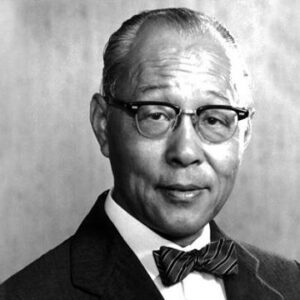An Wang was a Chinese-American computer engineer and inventor who did a lot of great work in the field of magnetic core memory. He came from China and became a very important person in the electronics business. His path to success began when he and a colleague made a pulse transfer device, which is a key part of the development of magnetic core memory. After he made this, he came up with the write-after-read cycle, which solved the problem of magnetic core memory’s destructive read out. This was a big step forward in making magnetic core memory devices a good way to store information. He made a lot of money from the many companies that used his patented design for building the memory pattern in computers. He used this money to start his own business, which is how Wang Laboratories came to be. The company became the best-selling brand of desktop calculators and also did well with word processors. He was an inventor with a good head for business, and he used his own ideas to grow his company. He was one of the most famous engineers and businesspeople of the 20th century. He made a big difference in the way computers were made.
Early years and childhood
On February 7, 1920, he was born in Shanghai, China, to an English teacher named Zen Wen Wang and his wife, Yin Lu.
He was the family’s oldest son. He had a big sister named Hsu, a little sister named Yu, and two little brothers named Ping and Ge.
When he was six, he went to the third grade, which was the first time he went to school for real. He was very interested in science and math, and his father taught him English.
He finished high school at one of China’s best schools, Shanghai Provincial High School. In 1940, he got a degree in electrical engineering from Chiao Tung University.
During World War II, he made radio senders and receivers for China.
After the war ended, he applied for a training program, got into Harvard University in Cambridge, Massachusetts, and got his master’s degree in 1946.
In 1948, he went to Harvard University and got his Ph.D. in Applied Physics.
An Wang’s Career
After getting his Ph.D., he started working at the Harvard Computation Laboratory under Howard H. Aiken. He made a patent for the pulse transfer controlling device that made magnetic core memory possible.
Through his patent, computer companies like IBM, which used magnetic core memories, paid him a lot of money in royalties.
In 1951, he started Wang Laboratories as a sole proprietorship, which meant that he was the only owner. In the first few years, money was tight, and the company grew slowly by selling magnetic shift registers and machines for controlling magnetic tapes that were made to order.
For his write-after-read cycle, he was given a patent for core memory. He sold this patent to IBM for $500,000. With that money, he and a partner grew their business.
In the middle of the 1960s, he made a digital logarithmic converter that made it possible to do simple math tasks quickly and cheaply on a computer. The company made a lot of money selling the calculators that were made with his idea.
In later years, he focused his company on making word processors and computers for small businesses. In 1976, the first Wang word processors went on sale.
In the early 1970s, Wang’s company began making minicomputers as well as calculators and word processors.
The company that began in one room grew over the years and moved its headquarters to Tewksbury, Massachusetts, and then to Lowell, Massachusetts, where it now has 30,000 employees.
In 1986, he retired so he could spend more time on educational activities. He gave his business to his oldest son, Frederick, to run. But in 1989, when the company was having trouble in the computer business, he went back to work.
Works of note
He was one of the people who made a device for controlling pulse transfer. In a magnetic core memory device, this was done by using the magnetic field of the core to switch the current on and off.
He came up with the idea of writing after reading. In what is called a “destructive readout,” the data in a magnetic core memory device are lost when the device is read. The write-after-read cycle rewrote the data back to its core, which made it easier to use.
He started Wang Laboratories, which grew to be an electronics company worth billions of dollars and employing 30,000 people at one point.
Awards & Achievements
In 1986, the United States gave him the Medal of Freedom.
In 1988, he was given a place in the National Inventors Hall of Fame.
The Institute of Electrical and Electronics Engineers made him a fellow.
Aside from that, he was a part of the American Academy of Arts and Sciences.
In his honor, a professorship in Computer Science and Electrical Engineering at Harvard University is named for him.
The Lowell Technological Institute gave him an honorary Doctor of Science degree.
Personal History and Legacies
He met Lorraine Chiu at a party, and in 1949, the two of them got married. They were lucky to have three kids. Their names are Frederick, Courtney, and Juliet.
In 1979, he set up the Wang Institute of Graduate Studies.
He also helped fix up the Boston Metropolitan Theater, which in 1983 was renamed the “Wang Theater.”
He died of cancer on March 24, 1990, in Boston, U.S.
Estimated Net worth
Wang was the fifth richest person in the country with a net worth of $1.6 billion. He gave away a lot of money to good causes, like hospitals, universities, and homeless shelters. In 1986, the government gave him the Medal of Liberty because he was one of the 12 best new citizens of the country.


